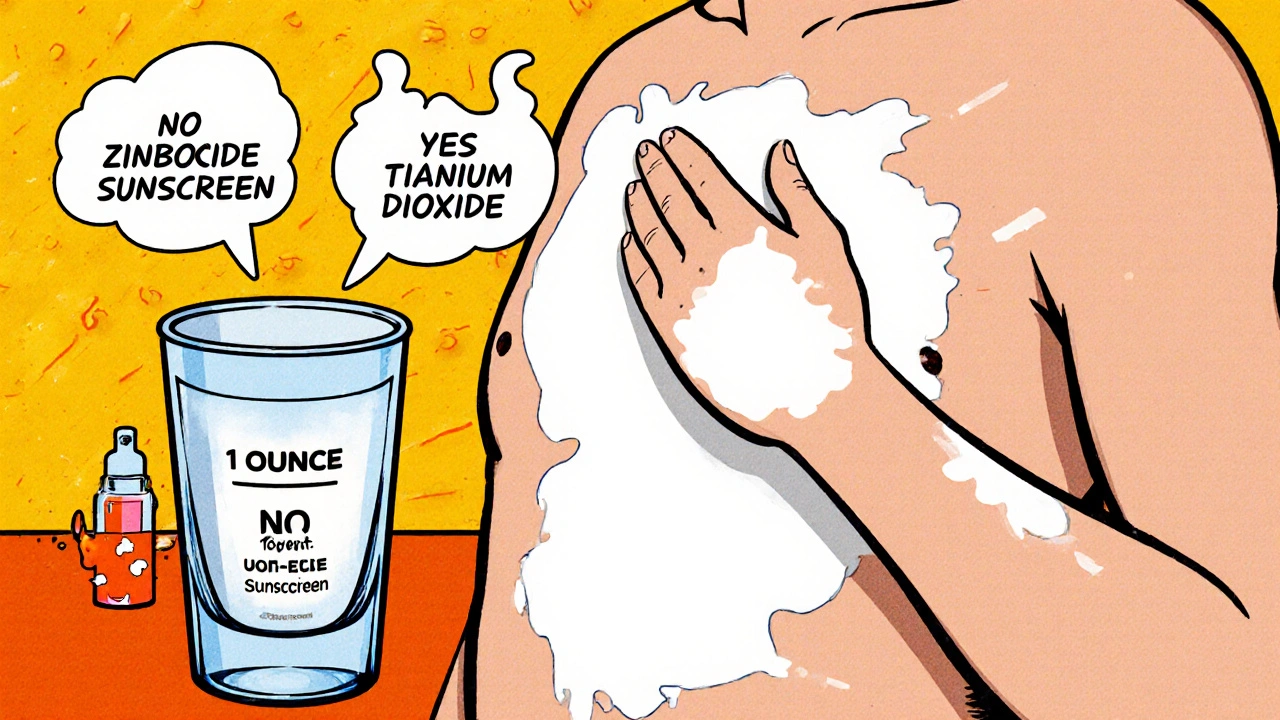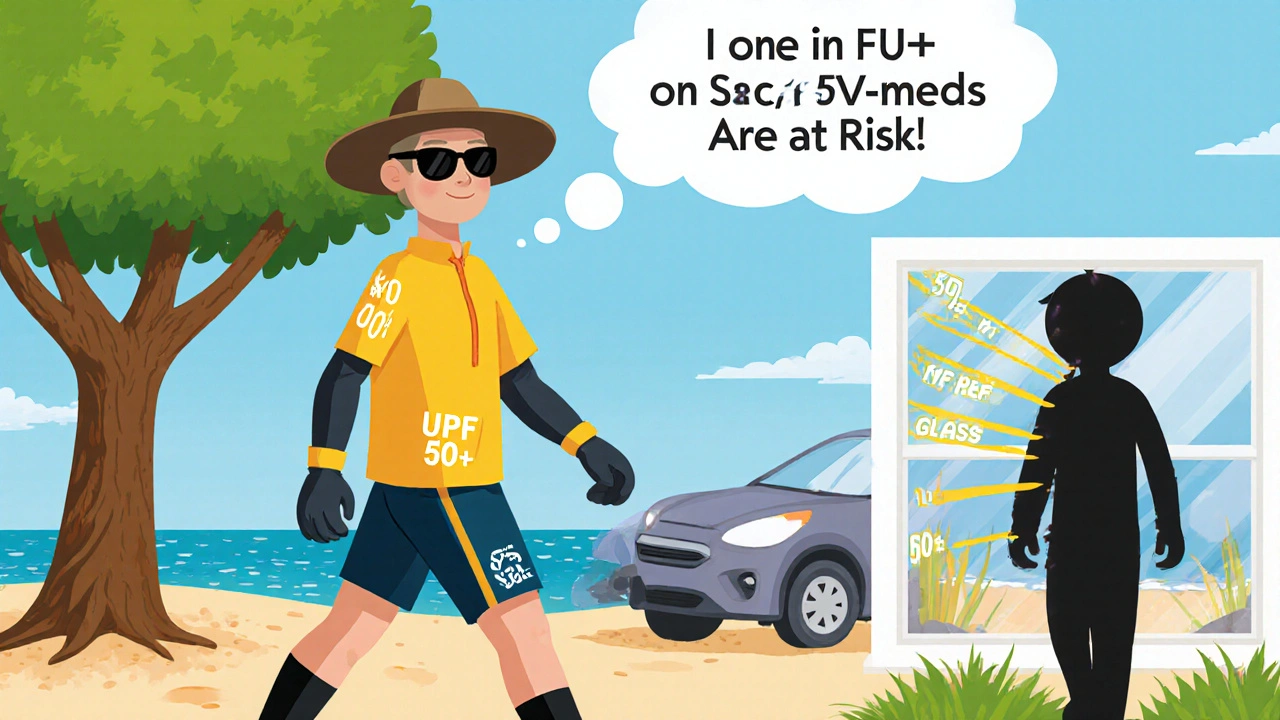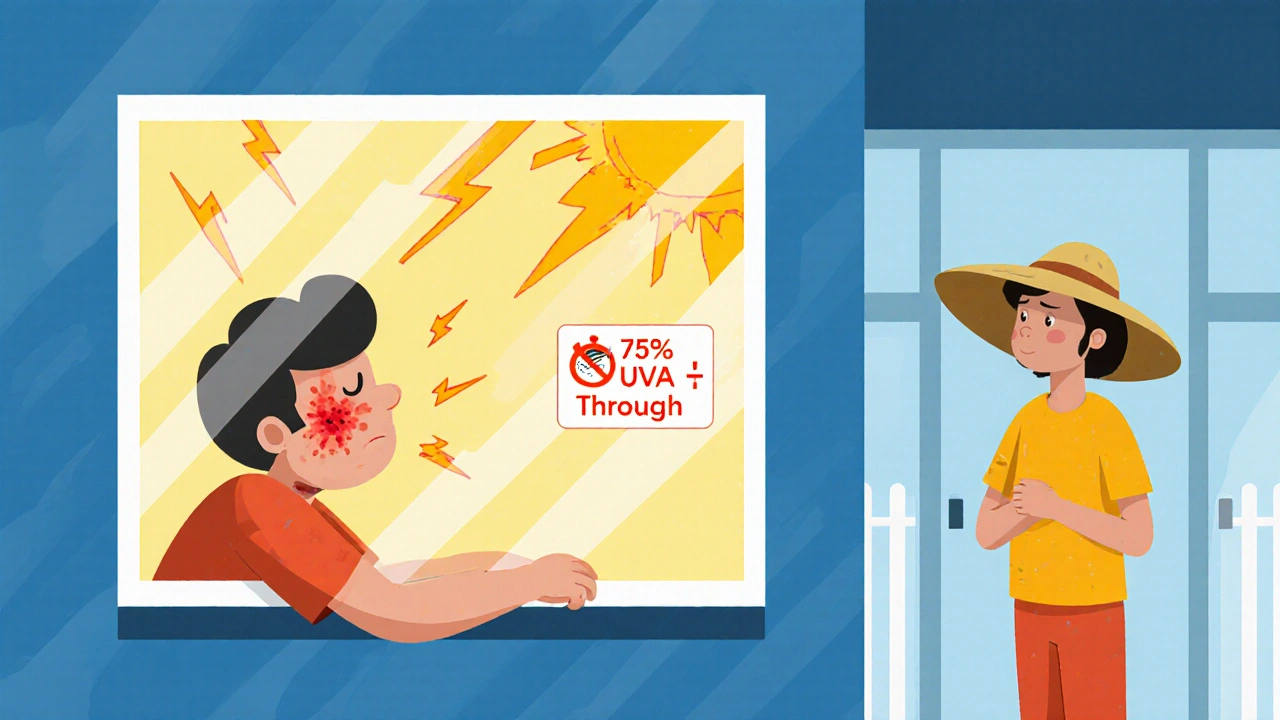Sunscreen Calculator for Photosensitivity
How Much Sunscreen Do You Need?
The Skin Cancer Foundation recommends 2 mg of sunscreen per square centimeter of skin. This calculator helps you determine your precise sunscreen needs based on your body size and activity level.
☀️ Your Sunscreen Recommendations
For a person with activity level and sunscreen:
Reapply every:
If you’ve ever gotten a bad sunburn after just 10 minutes outside - or developed a rash from sitting near a window - you might be dealing with photosensitivity. It’s not just being sensitive to the sun. It’s your skin reacting badly to UV light in ways that shouldn’t happen to most people. For some, even a quick walk to the car can trigger blisters, itching, or burning. And if you’re taking certain medications or have conditions like lupus, this isn’t just inconvenient - it’s dangerous.
What Causes Photosensitivity?
Photosensitivity isn’t one thing. It comes in two main forms: phototoxic and photoallergic. Phototoxic reactions are more common. They look like a bad sunburn - red, painful, sometimes blistering - and happen when certain chemicals in your body (often from medications) react with UV light. Think antibiotics like doxycycline, diuretics like hydrochlorothiazide, or even some NSAIDs like ibuprofen. These aren’t rare. One in four people on common prescriptions may be at risk. Photoallergic reactions are rarer and trickier. They’re immune-driven. Your body sees UV-altered skin compounds as invaders and starts attacking them. That means a reaction might not show up until days after sun exposure. It can spread beyond where the sun hit. DermNet NZ says this often comes from fragrances, sunscreen ingredients, or topical creams with retinoids or alpha-hydroxy acids. The key? You don’t need to be outside for long. Standard glass blocks 97% of UVB but lets through 75% of UVA. So if you sit by a window at work or drive with the windows up, you’re still getting hit. That’s why people with severe photosensitivity install UV-blocking film on their home and car windows - and why some end up working night shifts just to avoid daylight.Why Regular Sunscreen Isn’t Enough
Most people think SPF 30 sunscreen is enough. For someone without photosensitivity? Maybe. For someone with it? Not even close. The Skin Cancer Foundation recommends SPF 50+ for photosensitive patients. Why? SPF 30 blocks about 97% of UVB rays. SPF 50 blocks 98%. That extra 1% matters when your skin is this reactive. But SPF only measures UVB protection. You need broad-spectrum coverage - meaning it also blocks UVA. That’s the kind that penetrates deeper, causes aging, and triggers photoallergic reactions. Chemical sunscreens absorb UV light. But they can irritate sensitive skin. Zinc oxide and titanium dioxide? They sit on top of your skin and reflect UV. No absorption. No chemical reaction. Just protection. That’s why dermatologists consistently recommend mineral-based sunscreens for photosensitive individuals. Look for labels that say “zinc oxide” or “titanium dioxide” as the first active ingredients. And don’t forget application. You need 2 milligrams of sunscreen per square centimeter of skin. That’s about one ounce - a shot glass full - for your whole body. Most people use half that. And if you don’t reapply every two hours, or after sweating or swimming, you’re wasting your money. One Reddit user in r/skincancer said they set hourly phone alarms just to remember to reapply during their workday.UPF Clothing: Your Best Defense
Clothing is the most reliable form of sun protection. Unlike sunscreen, it doesn’t wash off, rub off, or degrade over time. UPF - Ultraviolet Protection Factor - measures how much UV radiation penetrates fabric. UPF 50 means only 1/50th (2%) of UV rays get through. That’s 98% blocked. The best fabrics? Thick, tightly woven polyester, denim, or wool. Dark colors absorb more UV than light ones. But if it’s hot, lightweight UPF 50+ cotton or bamboo blends are available now - designed specifically for comfort without sacrificing protection. You can buy shirts, hats, pants, and even gloves with UPF ratings. Some are so breathable, people with lupus wear them all summer without overheating. And here’s the thing: clothing protects better than sunscreen. No application errors. No missed spots. No need to remember to reapply. Combine it with sunscreen on exposed areas like your face and hands, and you’re building a layered defense.What About Shade and Windows?
Shade helps - but not as much as you think. A tree or umbrella blocks 50-95% of UV, depending on density and angle. But scattered UV still bounces off sand, water, and concrete. That’s why you can get burned under a beach umbrella. Windows are worse. Standard glass blocks UVB but lets 75% of UVA through. That’s why people with photosensitivity get rashes while driving or sitting near a window. The Cleveland Clinic says complete UV avoidance means treating windows like exposure points. UV-blocking window film - which blocks up to 99% of UVA - is a game-changer. It costs $5-$15 per square foot, but for someone with severe reactions, it’s medical equipment.
What Medications and Products Make It Worse?
This is critical. Many everyday items increase sun sensitivity. Antibiotics (tetracyclines, fluoroquinolones), diuretics, acne treatments with retinoids, NSAIDs, and even some antidepressants can trigger reactions. Always ask your pharmacist: “Is this photosensitizing?” Skincare is another hidden risk. Products with alpha-hydroxy acids (glycolic, lactic), beta-hydroxy acids (salicylic), retinol, or essential oils like bergamot, lime, or angelica can make your skin hyper-reactive. Stop using them during peak sun months - or better yet, avoid them entirely if you’re photosensitive.Supplements That Help - But Don’t Replace Protection
Some supplements offer backup protection. Polypodium leucotomos, an extract from a Central American fern, has been shown in studies to provide the equivalent of SPF 3-5. It doesn’t replace sunscreen, but it can reduce redness and damage when taken daily. Nicotinamide (vitamin B3) is even more promising. A major 2015 study in the New England Journal of Medicine found that taking 500 mg twice daily reduced new non-melanoma skin cancers by 23% in high-risk patients. DermNet NZ now lists it as a standard add-on for those with chronic photosensitivity. Don’t expect miracle results. These aren’t magic shields. They’re support tools - like seatbelts in a car. You still need the main protection: clothing, sunscreen, shade.Daily Routine for Photosensitive People
Here’s what a real, working routine looks like:- Check the UV index daily. Avoid being outside when it’s above 3 - usually between 10 a.m. and 4 p.m.
- Apply zinc oxide-based SPF 50+ sunscreen 15 minutes before going out. Use one ounce for full body coverage.
- Wear UPF 50+ long sleeves, wide-brimmed hat, and UV-blocking sunglasses.
- Reapply sunscreen every two hours - set phone reminders if needed.
- Install UV film on home and car windows.
- Avoid all photosensitizing skincare and medications unless approved by your doctor.
- Take nicotinamide or polypodium leucotomos daily as a preventive layer.
- Plan outdoor activities for early morning or late evening.

What Happens If You Skip Protection?
Photosensitivity isn’t just about discomfort. Repeated UV exposure in sensitive skin increases your risk of skin cancer - especially non-melanoma types like basal cell and squamous cell carcinoma. The Skin Cancer Foundation says one in five Americans will develop skin cancer by 70. For someone with chronic photosensitivity, that risk is much higher. And it’s cumulative. Each reaction adds to the damage. What starts as a rash can become scarring. What starts as a burn can become a lesion. Prevention isn’t optional. It’s medical necessity.Future of Photosensitivity Management
New tech is emerging. Smart fabrics with built-in UV sensors that change color when protection drops are in development. Next-gen window films block 99.9% of both UVA and UVB without tinting. Researchers are also exploring personalized sun protection plans based on genetic sensitivity and medication profiles. But for now, the tools we have work - if you use them right. No single method is perfect. Sunscreen alone fails. Clothing alone leaves your face exposed. Shade alone lets in scattered UV. You need all of it.Final Thought: It’s Not Overreacting - It’s Survival
People might say, “You’re being too careful.” But if you’ve ever woken up with blisters after sitting by a window, you know this isn’t about being extra. It’s about staying healthy. Photosensitivity is real. It’s common. And it’s manageable - if you treat it like the medical condition it is. Start with one change today. Check your medications. Buy a UPF hat. Install window film. Reapply sunscreen. Small steps add up. Your skin will thank you - and so will your future self.Can you get photosensitivity from sunlight through a window?
Yes. Standard glass blocks most UVB rays but lets through about 75% of UVA rays, which can trigger photosensitivity reactions. People with this condition often develop rashes or burns while sitting near windows at home or in the car. Installing UV-blocking window film is one of the most effective ways to prevent this.
Is SPF 30 enough for photosensitive skin?
No. SPF 30 blocks about 97% of UVB rays, but SPF 50+ blocks 98%. That extra 1% matters for photosensitive skin, which reacts to even small amounts of UV. The Skin Cancer Foundation and clinical guidelines recommend SPF 50+ with broad-spectrum coverage for people with photosensitivity.
What sunscreen ingredients are safest for photosensitive skin?
Mineral sunscreens with zinc oxide and titanium dioxide are safest. They sit on top of the skin and reflect UV rays instead of absorbing them, which reduces the chance of irritation. Avoid chemical sunscreens with oxybenzone, avobenzone, or octinoxate, which can trigger allergic reactions in sensitive skin.
Can medications cause photosensitivity?
Yes. Common culprits include antibiotics like doxycycline and tetracycline, diuretics like hydrochlorothiazide, NSAIDs like ibuprofen, and some antidepressants. Always ask your pharmacist if a new medication can make your skin more sensitive to the sun. Never stop taking prescribed meds without consulting your doctor.
Does UPF clothing really work better than sunscreen?
Yes, in most cases. UPF 50+ clothing blocks 98% of UV radiation consistently, without needing reapplication. Sunscreen can wear off, be applied too thinly, or miss spots. Clothing provides reliable, all-day protection and is especially useful for covering large areas like arms and legs.
Are there supplements that help with photosensitivity?
Yes. Nicotinamide (vitamin B3) at 500 mg twice daily has been shown in clinical trials to reduce new non-melanoma skin cancers by 23% in high-risk individuals. Polypodium leucotomos extract offers mild systemic protection (equivalent to SPF 3-5) and may reduce redness. These are supplements, not replacements for physical sun protection.
How do you know if your sunscreen is broad-spectrum?
Look for the words “broad-spectrum” on the label. In the U.S., this means the product has passed FDA testing for UVA and UVB protection. Also check the ingredients - zinc oxide and titanium dioxide naturally block both. Avoid products that only list SPF without mentioning broad-spectrum coverage.
Can you develop photosensitivity later in life?
Yes. Photosensitivity can develop at any age, especially after starting a new medication, being diagnosed with an autoimmune disease like lupus, or after prolonged sun exposure over time. Even people who never had issues before can suddenly react to sunlight. If you notice unusual rashes or burns after sun exposure, talk to a dermatologist.


so i just learned that glass lets in uva huh
imagine getting burned just chillin at your desk
my window at work is like a tanning bed lmao
i never realized sunscreen needs a shot glass full
im always using like a pea sized amount and wondering why i still burn
thanks for the reality check
to anyone reading this who thinks this is overkill
you haven’t woken up with blisters because you sat by a window
trust me i’ve been there
this isn’t being extra
this is surviving
you deserve to be outside without fear
the real conspiracy
pharma and sunscreen companies want you dependent on chemicals
they don’t want you to know zinc oxide works better
and they definitely don’t want you to know window film costs less than your monthly prescriptions
they profit from your suffering
as a dermatology nurse for 12 years
let me tell you the most common mistake i see
people think if they don’t turn red they’re fine
but photosensitivity isn’t about sunburn
it’s about cellular damage that builds silently
that rash you get after driving to work
that’s your dna getting nicked
and yes it adds up
every single time
the biochemistry here is fascinating
phototoxic reactions are direct cytotoxic insults
photoallergic are delayed-type hypersensitivity responses mediated by Langerhans cells
but colloquially
it’s just your skin screaming
and the fact that uva penetrates glass at 75%
means indoor exposure is not incidental
it’s pharmacokinetic
you’re not being paranoid
you’re just pharmacologically vulnerable
and the clinical imperative is layered defense
not just sunscreen
but clothing
film
timing
and systemic agents like nicotinamide
which modulates DNA repair pathways
and reduces immunosuppression
in high-risk phenotypes
it’s not magic
it’s medicine
just bought my first UPF shirt yesterday 😊
it’s so light i forgot i was wearing it
and i walked 3 miles in the sun and didn’t feel a thing
my skin has never felt this calm
also installed UV film on my car windows
it’s like having invisible armor
no more panic when i drive to work
and i finally sleep through the night without wondering if i’ll wake up in pain
you’re not alone out there
we’re building a quiet revolution
one hat
one film
one reapplication at a time 🌞🛡️
…and then, there’s the fact that… some medications… are… photosensitizing…
…and… people… don’t… know…
…because… their… doctors… don’t… tell… them…
…and… pharmacists… are… overworked…
…and… patients… just… take… the… pill…
…and… then… they… get… burned…
…and… no… one… connects… the… dots…
…so… maybe… we… should… all… ask…
…‘is… this… going… to… make… me… burn…’…
…every… single… time…
…please…
It is imperative to underscore that the efficacy of mineral sunscreens is empirically superior in the context of photosensitive dermatoses. The physicochemical properties of zinc oxide and titanium dioxide confer a non-absorptive, reflective barrier that mitigates photoreactivity. In contrast, chemical filters such as oxybenzone induce free radical generation and potential allergenic cross-reactivity. The clinical literature, including peer-reviewed studies published in the Journal of the American Academy of Dermatology, consistently supports this position. Furthermore, the notion that SPF 30 is adequate is not merely incorrect-it is dangerously misleading. The incremental benefit of SPF 50+ is not statistically trivial; it is clinically significant for high-risk populations. One must also acknowledge that UPF-rated apparel represents the gold standard of photoprotection, as it is impervious to user error, degradation, or misapplication. The integration of these modalities constitutes a multimodal, evidence-based strategy. To neglect any component is to compromise one’s integumentary integrity.
so like
you gotta wear a full suit
and put film on your windows
and take pills
and set alarms
and avoid the sun
and check your meds
and use a shot glass of sunscreen
…and still get cancer
why even try
life’s a sunburn anyway
Thank you for this comprehensive and clinically grounded overview. I have shared this resource with my patients who present with lupus-related photosensitivity. The emphasis on layered protection-UPF clothing, mineral sunscreens, and window film-is both practical and evidence-based. Many patients underestimate the penetrative capacity of UVA through standard glass. Your guidance on nicotinamide supplementation, referencing the NEJM trial, is particularly valuable. This is not an overreaction. It is a necessary medical protocol.
My grandma had porphyria. She wore gloves indoors. Sunglasses at night. She’d pull the curtains at 10 a.m. and call it ‘sun safety.’
People called her weird.
She lived to 94.
She never got skin cancer.
So yeah.
Maybe being ‘too careful’ is just what survival looks like.
And maybe the rest of us are just lucky… so far.
they’re lying about the UV index
it’s not about sun exposure
it’s about the government testing 5G towers
and your skin is the canary
they don’t want you to know that zinc oxide blocks more than UV
it blocks the frequencies they’re broadcasting
that’s why they sell you chemical sunscreens
that’s why they don’t fund UV film research
they want you to keep burning
so you stay dependent
so you keep buying
so you never question the system
and the truth is
you’re not just protecting your skin
you’re resisting surveillance